Excerpts from Jim Conrad's
Naturalist Newsletter
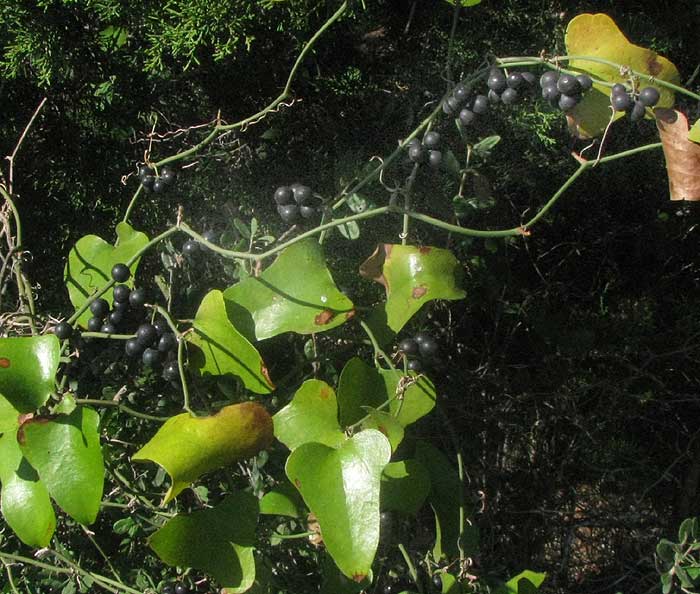
from the November 11, 2012 Newsletter issued from the valley of the Dry Frio River in northern Uvalde County, southwestern Texas, on the southern border of the Edwards Plateau; elevation ~1750m (~5750 ft); N29.62°, W99.86°; USA
GREENBRIARS FRUITING
Above you see a semi-woody vine that's fairly common in these parts, especially at weedy woods edges and along roads. Notice the leaves' distinctive shape, with broadly lobed bases and pinched-in sides, and their shininess. Also note the clusters of black, grapelike fruits suspended above the vine's main stem. They're so black they almost disappear against the shadowy background. A closer look at a fruit cluster is shown below.
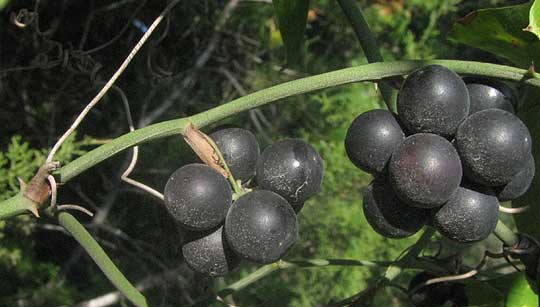
In that picture also notice the short, broad-based spines along the stem. Though the berry-type fruits are only about 5/16ths inch across (7mm) they look good enough to eat. However, if you bite into one you find very little flesh at all, nearly the entire berry being occupied by a hard seed, as shown below:
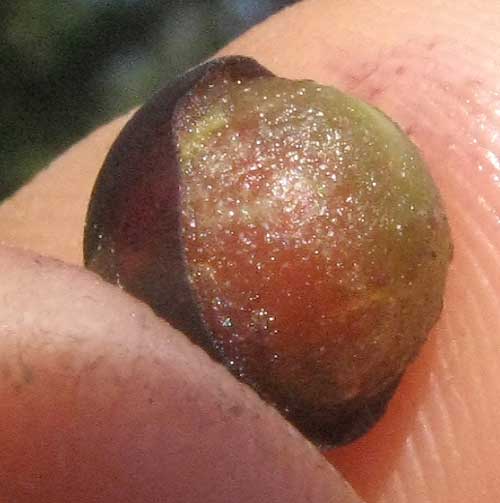
Probably you're familiar with this kind of spiny vine, but what you call it may depend on which section of the country you live in, or which field guide you learned its name from. Maybe the most common English name for the plant group -- the genus Smilax -- is greenbriar, though it's also called catbrier, sawbriar, sarsaparilla, and other names. The species in our pictures is SMILAX BONA-NOX, in this area apparently usually called Saw Greenbrier, but in other places it's known as Bullbrier, Chinabrier, Tramp's Trouble and by other names. The "bona-nox" species name means "good night" in classical Latin. It's unclear why Linnaeus, who named the plant in 1753, gave it this name. The page editor for the species at the Duke University website suggests that "bona-nox" might have been a Latin curse, something said when one scrapes unprotected ankles along this spiny species' stems.
I grew up with Smilax bona-nox in the western Kentucky countryside and it grew all around my hermit camp in Mississippi, so it's bloodied my ankles many times. The species' distribution is mainly the US Southeast, extending as far north as southern New Jersey and central Missouri. Here in southwestern Texas we're about at its western extreme of distribution, though it continues much farther south into eastern Mexico.
Around here the fruits of Smilax bona-nox are eaten by Wild Turkeys, Opossums, Raccoons, squirrels, and many species of songbirds. White-tailed deer browse the foliage.
from the January 12, 2014 Newsletter issued from the Frio Canyon Nature Education Center in the valley of the Dry Frio River in northern Uvalde County, southwestern Texas, on the southern border of the Edwards Plateau; elevation ~1750m (~5750 ft); N29.62°, W99.86°; USA
GREENBRIAR IN WINTER
Our several hard freezes don't seem to have hurt the Greenbriar's grapelike fruits now dangling in pretty, blackish clumps from leafless stems, as shown below:
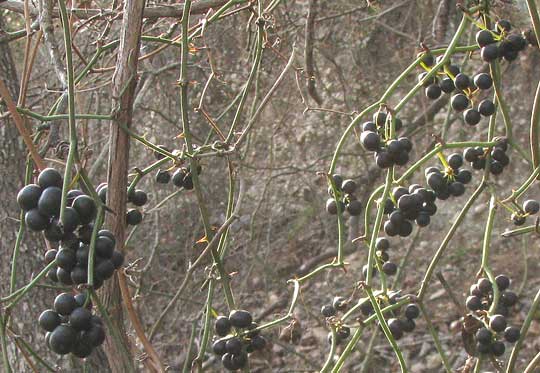
In that picture they look larger than they really are. They measure only 5/16ths inch across (7mm). They look so luscious that you wonder why birds haven't eaten them all. However, if you pluck a fruit and pop it into your mouth, you might decide that there's not much eating to it. Below, you can see a fruit with some skin gnawed off to reveal two seeds inside:
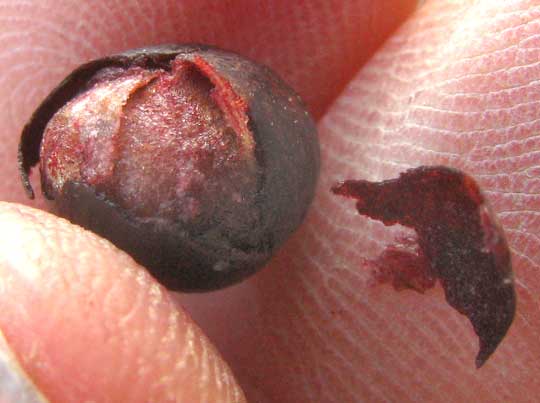
The thin, leathery skin is practically tasteless.
Technically, Greenbriar fruits are berries, which means that they are pulpy, arise from a flower's single pistil, and contain one or more seeds that are not large and hard enough to be called a stone. Therefore, a peach isn't a berry, but a tomato is. Blackberries and strawberries, technically, aren't berries.